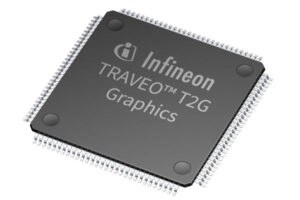A user-friendly cockpit solution based on Infineon’s TRAVEO CYT4DN MCU family and an entry-level MediaTek Dimensity Auto SoC solution that lowers system BOM costs for both hardware and software have been developed by Infineon Technologies in collaboration with MediaTek and its design house partners.
The Infineon CYT4DN MCU assists the SoC in meeting the ASIL-B safety target for automotive clusters in this user-friendly cockpit solution. In addition to normal companion functions like connection with the vehicle network, the TRAVEO MCU monitors the content rendered by the SoC and takes over with reduced functionality in case of an error.
“Our automotive SoC, combined with Infineon’s TRAVEO T2G MCU, will provide a cost-effective cockpit solution that delivers new possibilities to OEMs and Tier 1 companies,” said Mr. Xiong Jian, vice general manager of the Automotive product line at MediaTek. “This option will greatly boost the performance and capabilities of the cockpit in entry-level car models.”
“A modern cockpit supports the driver and increases driving comfort for all vehicle occupants. That is why it is important to us that cost optimized vehicle models can also be equipped with digital solutions. Together with MediaTek and our partners, we are pleased to pave the way for digital cockpits for all vehicles,” said Ralf Koedel, Vice President Microcontroller Smart Mobility at Infineon. “The TRAVEO T2G CYT4DN MCU incorporates our low-power flash memory, multiple high-performance analog and digital peripherals and enables the creation of a secure computing platform.”
The in-vehicle infotainment display and clusters supports a resolution of 1920 x 720 pixels making the cockpit system pretty innovative and attractive. Highly driven by the ASIL-B-compliant TRAVEO CYT4DN MCU, which powers the cluster display maintaining high reliability.
Because the SoC operates on the open-source Android operating system, it does not require a hypervisor or a large commercial operating system, which simplifies and greatly lowers the cost of the software. This eliminates the requirement for significant software purchases or license costs. Further cost savings can be achieved by suppliers and manufacturers updating and maintaining the software themselves.
TRAVEO T2G MCUs enable secure computing platforms
A family of TRAVEO T2G microcontrollers called the TRAVEO CYT4DN was designed especially for automotive systems, including head-up displays (HUD) and instrument clusters. The devices, which are produced using a cutting-edge 40nm process, have two Arm® Cortex®-M7 CPUs for primary processing at up to 320 MHz, sound processing, and one Arm® Cortex®-M0+ CPU for peripheral and safety processing. The family also includes a special 327-ball BGA package and a 720p GFX.
Furthermore, the TRAVEO T2G CYT4DN series has integrated peripherals supporting Gigabit Ethernet, Local Interconnect Network (LIN), Clock Extension Peripheral Interface (CXPI), and Controller Area Network with Flexible Data Rate (CAN FD). There are three different memory configurations available: 4MB of VRAM, 6MB of Flash, and 768KB of RAM per line.
The Growing Traction of Digital Cockpits
The automotive industry is moving toward digital cockpits, where sophisticated displays are taking the role of dashboard buttons and controls. The digital cockpit system, one of a car’s major systems, must fulfill functional safety standards and provide high-performance features to its users. The digital cockpit system is often operated on a high-performance SoC with a hypervisor in order to accomplish such aims.
But the initial outlay needed to implement such a system is in the seven-figure region, and the license fees for the hypervisor and operating system raise the system’s total cost, rendering it unfeasible for mid-to low-end automobile models.
Availability
For Further Information on Availability: CLICK HERE




